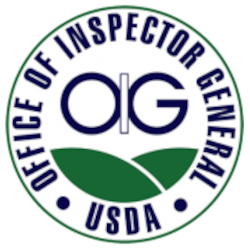USDA's Compliance with Improper Payment Requirements for FY 2023
Report Information
Recommendations
We recommend that for Each Year of Non-Compliance:a. FSA should provide information for FSA ECP-Disasters, LFP, and NAP, describing the actions that the agency will take to come into compliance, in the OMB Annual Data Call. This information will be published on paymentaccuracy.gov and serve as the plan that agencies are required to submit to the appropriate authorizing and appropriations committees of Congress, including:i. Measurable milestones to be accomplished in order to achieve compliance for each program;ii. The designation of a senior agency official who shall be accountable for the progress of the executive agency in coming into compliance for each program; andiii. The establishment of an accountability mechanism, such as a performance agreement, with appropriate incentives and consequences tied to the success of the senior agency official in leading the efforts of the agency to come into compliance for each program.
We recommend that for Each Year of Non-Compliance:b. FNS should provide information for FNS SNAP, describing the actions that the agency will take to come into compliance, in the 0MB Annual Data Call. This information will be published on paymentaccuracy.gov and serve as the plan that agencies are required to submit to the appropriate authorizing and appropriations committees of Congress including:i. Measurable milestones to be accomplished in order to achieve compliance for each program;ii. The designation of a senior agency official who shall be accountable for the progress of the executive agency in coming into compliance for each program; andiii. The establishment of an accountability mechanism such as a performance agreement, with appropriate incentives and consequences tied to the success of the senior agency official in leading the efforts of the agency to come into compliance for each program.
We recommend that for the Second Consecutive Year of Non-Compliance:a. FSA should propose to the director of OMB in its next budget submission additional program integrity proposals for LFP that would help the program come into compliance. This process will unfold as part of the annual development of the President's budget. In the budget submission, the agency should describe how each proposal would help the program come into compliance.b. If the director of OMB determines that additional funding would help the program become compliant, the agency should obligate an amount of additional funding determined by the director of OMB to intensify compliance efforts. When providing additional funding for compliance efforts, the agency should:i. Exercise reprogramming or transfer authority to provide additional funding to meet the level determined by the director of OMB; andii. Submit a request to Congress for additional reprogramming or transfer authority if additional funding is needed to meet the full level of funding determined by the director of OMB.
We recommend that for the Third Consecutive Year of Non-Compliance:a. FSA should submit to the appropriate authorizing and appropriations committees of Congress, OMB, and the Comptroller General of the United States a report on ECP Disasters that includes:i. Reauthorization proposals for each discretionary program that has not been in compliance for three consecutive years; and/orii. Proposed statutory changes necessary to bring the program that has not been in compliance for three consecutive years into compliance.If the agency determines that the two actions above will not bring the program into compliance, then the report must provide:111. A description of the actions that the agency is undertaking to bring the program into compliance; andiv. A timeline for when the program will achieve compliance based on the actions described.
We recommend FNS ensure proper reporting and classification of its CACFP. If FNS is unable to report improper payment information for all three components of the program, FNS should evaluate if some payments should be considered unknown payments.

